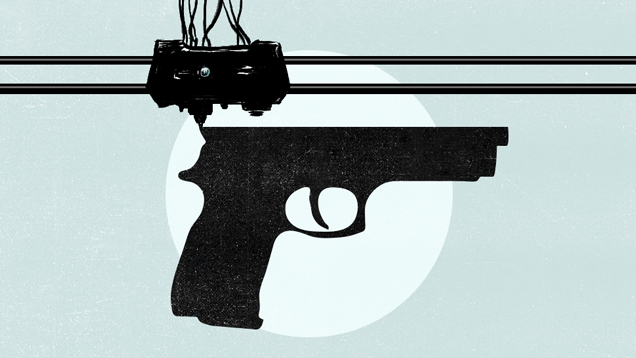A couple years ago, when a 25-year-old law student in Texas said he was going to 3D-print a gun, nobody took him seriously. Then, he actually did it. And then, a lot of people started doing it. Now, it’s so easy that some protestors are going make a gun inside the Texas State Capitol with a special gun machine. This is scary stuff, and it’s going to get worse.
The 3D-printed gun debate is a frustrating one for peace-loving Americans. On one hand, it really does feel like it should be illegal to plug in a machine, wait a few hours, and then get a plastic however durable gun that can possibly slip through metal detectors. Guns are dangerous. They kill people. Surely, there should be some sort of oversight.
But on the other hand, there is. It’s called the Bill of Rights, and it fully supports citizens’ right to bear and manufacture arms. Gunsmithing is completely legal as long as you don’t sell the guns you make. However, gunsmithing has historically been a pretty difficult endeavour, requiring metal and woodworking skills to make a sturdy, dependable weapon. The Bureau of Alcohol, Firearms, and Tobacco told me a while ago that they’re aware of this 3D printing thing, but remain unconvinced that it can produce a “consistently reliable” firearm. But that may not always be the case.
As we all now know, 3D printing a gun that fires bullets requires almost no skills at all. Cody Wilson, the law student who gained fame for creating the first fully 3D-printed gun, didn’t even know how to operate a 3D printer when he set out to make a gun. It took him less than a year to design and print his first gun, “The Liberator.” Then, he uploaded the files that let anybody 3D-print the gun to the internet, and over 100,000 people downloaded them before the State Department took down files. In the meantime, Wilson showed off an AR-15 with 3D-printed parts that could fire hundreds of rounds. That sounds pretty consistently reliable.
Guess what: 3D-printing a gun is going to get even easier. Less than a week into 2015 and three days into CES, it’s already clear that the 3D-printing industry is on the cusp of a significant transformation. So far, we’ve seen not one but two multi-material 3D-printers aimed at consumers. That means that tech savvy folks willing to spend a few thousands dollars can now start printing things out of composites like limestone, bronze, and iron.
There are countless exciting things that these new, more complex, and more powerful 3D printers can do. Meanwhile, the 3D printer market in general is becoming more accessible for the average American. (It’s already as cheap as $US25 to 3D-print a gun, if you already have a printer.) Wilson’s company, Defense Distributed, is even selling a device called a CNC mill that can make gun parts to complement 3D printed gun parts for just $US1200. It’s specifically designed to make metal guns, and it’s called the Ghost Gunner.
The confluence of these two factors suggests that it’s now not just easier to 3D print guns. It’s easier to 3D-print more advanced guns. And 3D-printed guns are already pretty advanced. In recent months, we’ve seen metal laser sintering technology produce 3D-printed guns that can fire thousands of rounds and are practically indistinguishable from manufactured guns. We’ve seen durable rifles that are entirely 3D-printed. Heck, we’ve even seen custom bullets that are specifically designed to work with 3D-printed guns. The inventor hopes to use them to produce semiautomatic and even fully automatic 3D-printed guns.
So where does the government stand on all this? Well, nobody seems to want to touch the issue of 3D-printed guns, probably because it’s inevitably a constitutional issue. (In addition to the obvious Second Amendment implications, there’s the First Amendment issue of allowing the plans for printing 3D guns to be published.) Again, it’s currently legal to 3D-print guns, and it will remain legal until lawmakers make laws that make it illegal. The ATF is not a policy-making agency, so they can’t enforce a law that doesn’t exist. Congress already missed one opportunity to regulate 3D-printed guns, and it’s unclear if this will be a priority for the new Republican majority on Capitol Hill.
This is how it usually works, though. Americans create technology much faster than lawmakers can regulate it. That can be a positive thing; in this case, however, it’s a dangerous one. As Cody Wilson said when he created the first 3D-printed gun, “I recognise that this tool might be used to harm people — It’s a gun.” And guns are scary for that very specific reason, especially when they’re cheap and easy to make.
Picture: Jim Cooke
